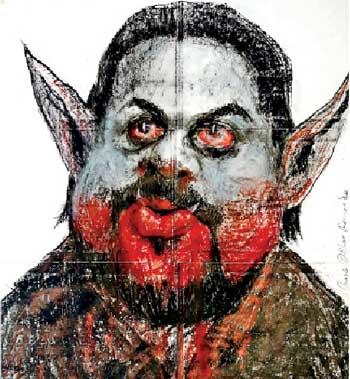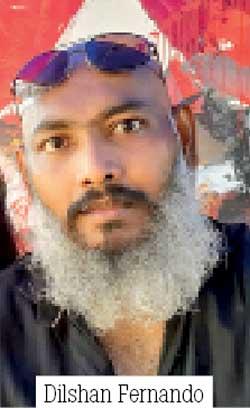10 Jun 2022 - {{hitsCtrl.values.hits}}
 A series of caricatures of prominent political personalities, recently did their rounds on social media. Many of them coincided with the prevailing political and economic crisis. The artist, Dilshan Fernando, is more or less a self-taught caricature artist who is in the process of mastering the art of caricature drawings. “When we draw caricatures, we look at a feature that is significant to that person,” he explained in an interview with the Daily Mirror Life. “For example, if we draw J. R. Jayawardena we concentrate on his nose. Therefore we try to exaggerate on certain features in order to highlight a character.”
A series of caricatures of prominent political personalities, recently did their rounds on social media. Many of them coincided with the prevailing political and economic crisis. The artist, Dilshan Fernando, is more or less a self-taught caricature artist who is in the process of mastering the art of caricature drawings. “When we draw caricatures, we look at a feature that is significant to that person,” he explained in an interview with the Daily Mirror Life. “For example, if we draw J. R. Jayawardena we concentrate on his nose. Therefore we try to exaggerate on certain features in order to highlight a character.”
"In Sri Lanka, cartoonists think that caricatures are about having an enlarged face and a tiny body. But it’s the face that needs to be distorted. More than being funny there’s a lot to do with portraying emotions."
 Having studied art until O/Ls, Fernando later joined Vibhavi Academy of Fine Arts in 2004.“I was at the Academy till 2010 and I specialised in landscape drawings. Thereafter I left for Dubai as I took up an art-related profession. I was aware about caricatures but I always thought that landscapes and portraits were powerful modes of communication. While I was in Dubai, my superior introduced me to caricature paintings in more detail. There are places in Dubai where you cannot even paint a butterfly. I was only allowed to paint fruits in the area where I lived. We couldn’t draw figures. When I came back I wanted to do something of my own. Then from 2010 until 2015 I did many self portraits but due to a personal issue I burnt all of them. From classical to abstract I distorted my face and since I haven’t tried my hand on caricatures I wanted to experiment more. Since December 2017 I have been drawing caricatures.”
Having studied art until O/Ls, Fernando later joined Vibhavi Academy of Fine Arts in 2004.“I was at the Academy till 2010 and I specialised in landscape drawings. Thereafter I left for Dubai as I took up an art-related profession. I was aware about caricatures but I always thought that landscapes and portraits were powerful modes of communication. While I was in Dubai, my superior introduced me to caricature paintings in more detail. There are places in Dubai where you cannot even paint a butterfly. I was only allowed to paint fruits in the area where I lived. We couldn’t draw figures. When I came back I wanted to do something of my own. Then from 2010 until 2015 I did many self portraits but due to a personal issue I burnt all of them. From classical to abstract I distorted my face and since I haven’t tried my hand on caricatures I wanted to experiment more. Since December 2017 I have been drawing caricatures.”
Fernando uses everything from pencils to charcoal and pastels to add more depth to his drawings.
When asked about how people comprehend satire, he said that people are still not familiar with satire. “It doesn’t have to be caricatures, people don’t understand many genres of art. That too is understood by a niche community, often in Colombo and suburbs. If people in the outskirts are to be literate about arts, it has to start with education. Many people know about the Mona Lisa painting but they don’t know the artist. It’s the same when it comes to my drawings as well. This is a disadvantage to an artist and it’s always a challenge to spread the message across.”
However, Fernando feels that the Galle Face protest is a starting point for a change in the mindsets of people. “When we draw a caricature we link it to a certain incident or something that the person has said,” he explained further. “If we take Francisco de Goya, a caricature artist in Spain, his portraits are distortions with colours, medals etc. But the paintings look like dead bodies. I have participated at international contests and I know a few renowned caricature artists. In Sri Lanka, cartoonists think that caricatures are about having an enlarged face and a tiny body. But it’s the face that needs to be distorted. More than being funny there’s a lot to do with portraying emotions.”
 When asked about the role of art in a people’s struggle, Fernando recalled the May 9 violence. “One of the first places they burned down was the art gallery. That is the best example I can think of. That itself shows the impact of art during a revolution. This is not to say that the threats have ended there. We do get disturbing messages from people who think we are affiliated to a certain political party. In reality we are independent artists. This is the first time protests of this nature happened in Sri Lanka and I think we have achieved a lot from this people’s struggle.”
When asked about the role of art in a people’s struggle, Fernando recalled the May 9 violence. “One of the first places they burned down was the art gallery. That is the best example I can think of. That itself shows the impact of art during a revolution. This is not to say that the threats have ended there. We do get disturbing messages from people who think we are affiliated to a certain political party. In reality we are independent artists. This is the first time protests of this nature happened in Sri Lanka and I think we have achieved a lot from this people’s struggle.”
He further said that he has given permission to use his caricatures and other artworks. “We cannot think of copyrights at this point. I have taught art free-of-charge. My problem is that the younger generation is not keen to learn about art. They try to commercialise the industry. But art is not a job.”
Fernando says that one of the biggest weaknesses in the art industry is that those involved are not willing to experiment with novel concepts. “If somebody does a creation, others tend to copy and replicate that concept. It’s alright to follow but they shouldn’t copy because they will lose their identity. Many feel that it’s more convenient to copy somebody else’s work and put their signature and make it their own. The younger generation shouldn’t follow this trend.”
“I aspire to do a caricature exhibition in future,” he said, talking about future aspirations. “I firstly need to study the depths of caricature drawings. Some of them got destroyed while moving houses and with the pandemic and the prevailing crisis this plan got delayed. But an exhibition is definitely on the cards,” he said in his concluding remarks.

23 Nov 2024 58 minute ago
23 Nov 2024 1 hours ago
23 Nov 2024 3 hours ago
23 Nov 2024 4 hours ago
23 Nov 2024 6 hours ago